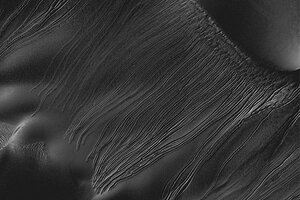Giant claw marks on Mars dunes? Blocks of dry ice to blame, study says.
Experiments with dry ice in Utah supported the theory that the narrow gullies spotted on some Martian dunes were caused by the annual spring thaw of chunks of frozen carbon dioxide.

This image from NASA's Mars Reconnaissance Orbiter shows the longest 'linear gullies' known on Mars, extending almost 1.2 miles on the side of a large sand dune inside Russell Crater.
NASA/JPL-Caltech/Univ. of Arizona
For years, scientists have puzzled over the source of narrow, dead-end gullies that run like claw marks down the slopes of some Martian dunes.
The perpetrator? No oversized cosmic tabbies here. Instead, these tracks appear to be etchings left by chunks of frozen carbon dioxide – dry ice – on their annual death slides as the southern hemisphere's winter gives way to spring, according to a new study.
The tracks appear in high-resolution images taken by NASA's Mars Reconnaissance Orbiter (MRO) as it passed over dunes located at the planet's high southern latitudes.
The narrow gullies start at or near the tops of the dunes. Some merge with other, larger channels on the way down the slope. But all end abruptly.
Some researchers have suggested they were formed by water, perhaps coming from near-surface ice that became exposed and with the warming of spring melted and briefly flowed downhill. But none of the narrow gullies display the extended fans of material at the bottom typical of debris flows seen elsewhere. Such flows can be triggered by the flash thawing of water ice near the surface, which then travels down slope. Or they can occur through dry processes akin to mini-avalanches.
In short, "these look more like something that is carved out of the surface" instead of features related to flowing water, says Serina Diniega, a researcher at NASA's Jet Propulsion Laboratory in Pasadena, Calif., and the lead author of a formal report on the findings set to appear in the July issue of the journal Icarus.
Indeed, co-author Chris Hugenholtz, a geologist at the University of Lethbridge in Alberta, Canada, buttonholed Dr. Diniege at a science conference where she had presented this interpretation of the gullies and noted he'd seen similar features etched into hillsides by rolling boulders. But in these locations, Mars had none of those.
MRO, which has been orbiting the red planet since March 2006, has monitored the dunes through three winters. During the winter, the dunes are covered with carbon-dioxide frost. The gully-like features appear in early spring.
Perhaps the features had something to do with seasonal changes in the ice?
Such changes have left their mark elsewhere on the planet. In 1998 and '99, Mars Global Surveyor returned images of what researchers dubbed "spiders" at high southern latitudes. These features, tendrils of dark material radiating from central points atop a layer of seasonal CO2 ice, appear on ridges and on slopes of dunes. One explanation for the spiders holds that the ice is transparent to sunlight, which warms the underlying soils and begins to thaw the ice from underneath. Once enough CO2 gas accumulates under one location, it can erupt through the ice in a dry geyser that forms channels on the surface that fill with soils the eruption brings with it.
Another member of the team reporting the new results, Candice Hansen of the Planetary Science Institute in Tucson, has been studying the effects that the appearance and disappearance of seasonal CO2 ice have on the Martian landscape, including the spiders. She also proposed that the gullies were formed by something rolling downhill – perhaps blocks of CO2 ice.
During a visit to Utah, where Dr. Hansen lives, Diniega stopped by to talk about the observations. The two researchers decided to stop at a local grocery store for some dry ice, then visit some small dunes nearby to take the ice for a test drive to see if the idea was plausible.
As suspected, the ice slid easily down the gentle dunes. So Diniega conducted two more sets of tests, making more-rigorous measurements, at dune fields in southern Utah and at Kelso Dunes, the largest dune field in southern California's Mojave Desert. The hypothesis held up. Some ice blocks never stopped until they reached the bottom or hit a bush.
What was happening? The warm dry sand was melting the underside of the ice to generate a cushion of CO2 gas underneath. A bit like air under a hovercraft, the layer of gas beneath the ice in effect greased the skids for the downhill run, even on gentle slopes. As the slabs of ice traveled, they pushed sand aside until they stopped, leaving an abrupt end to the mini-gullies they formed.
Modeling work performed by Planetary Science Institute researcher Jim McElwaine found that the same process would work, even at the much colder temperatures on Mars. [Editor's note: The original version of this story did not include this paragraph.]
"We have seen blocks of ice sitting in the channels in our HiRISE images," said University of Arizona planetary scientist Alfred McEwen, who also is the lead scientist for HiRISE, which took the images, in a prepared statement. "Later, we saw them disappear by sublimation, in a matter of months."
During sublimation, ice morphs from solid to gas without passing through a liquid state.
It's unclear whether the experiment will spawn a new sport – dry-ice races. During the experiment in southern California, a number of Diniega's JPL colleagues were present and found themselves cheering on various blocks of ice as they slid and pirouetted down the dune slopes.
But the team will continue to scan HiRISE images for more evidence of ice carving gullies in dune slopes to continue to build their case.

